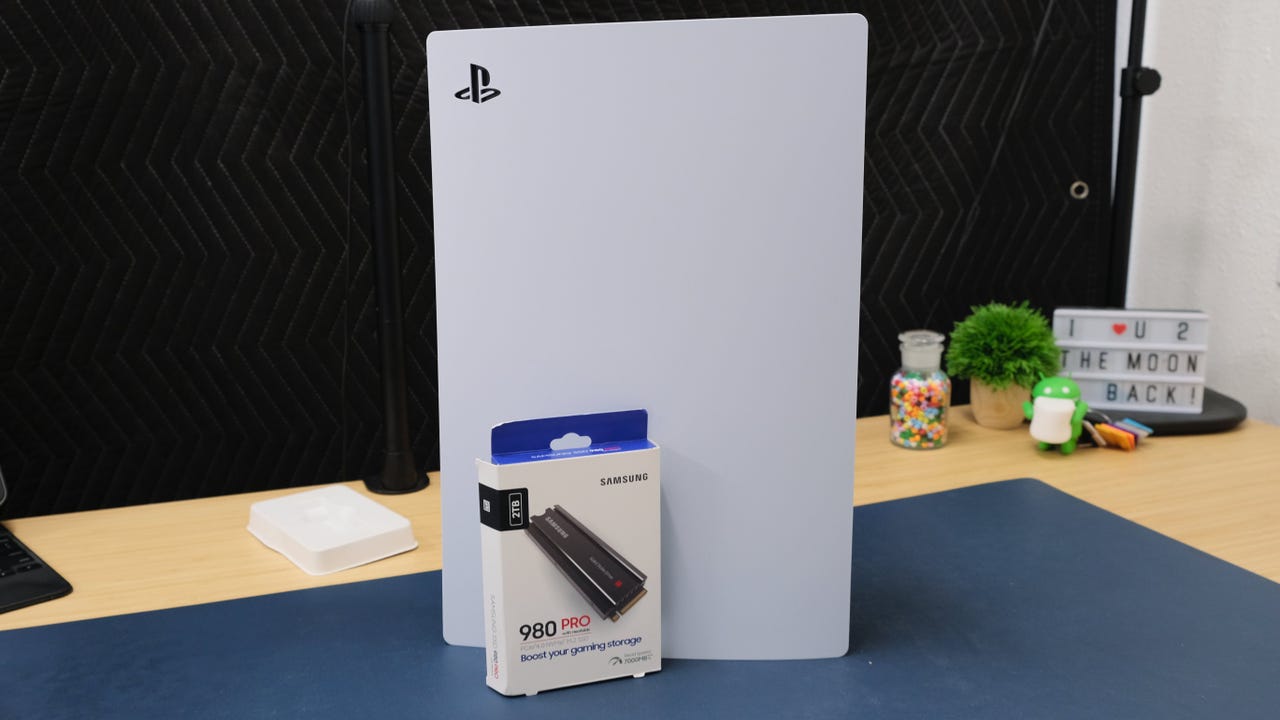































 Jason Cipriani/
Jason Cipriani/ Sony's PlayStation 5 comes with 1TB of storage, of which just over 800GB is actually available for storing games and other content you create when using the PS5. As game installation sizes continue to increase, it's only a matter of time before you'll fill up the internal PS5 storage and be left with the decision of deleting a game or adding more space.
You can add external storage via a USB port on the console, but you're going to run into performance hiccups due to the speed of the connection and drives. Instead of adding external storage, you can add another SSD to your PS5 using the built-in and empty SSD slot, which should help alleviate any performance issues.
Also: The best PS5 external hard drives for storing all your games
Below I'll walk you through what you'll need and the steps you'll take to install an SSD in your PlayStation, expanding your gaming storage.
What you'll need:To add additional storage to your PlayStation 5 using the built-in SSD slot, you'll need some supplies.
You'll, of course, need an SSD. There's a certain type of SSD that Sony requires. More specifically, you'll need a PCIe 4.0 M.2 SSD with a heatsink. That's a lot of jargon, I know. But the good news is, pretty much every company that makes SSDs has an SSD that'll work with and is advertised for the PS5.
Also: The best PS5 games
I used aSamsung 980 Pro with Heatsink that meets all of Sony's requirements and comes in various storage capacities.
If you don't want to buy an SSD that has a heatsink already attached, you can buy a third-party option. There are a few listed on Amazon, but I haven't tested any of them myself.
Also: How to cool your Raspberry Pi (and should you?)
Finally, you'll need a#1 Phillips head screwdriver. I have this kit from iFixit and use it all the time -- highly recommend.
I'd never installed an SSD in PS5, and it took me under 10 minutes from start to finish.
Before you begin, power off the PS5 and unplug the power cable, HDMI, and anything else connected to it. Lay the console on a table, with the front of the console (it's the side with the PS logo) facing down, and the rear of the console towards you. I put mine on top of a desk mat to prevent scratches on the case.
Also: The best PS5 headsets you can buy
To gain access to the SSD slot, you'll need to remove the back cover. If you have it positioned face down and the back of the console facing you, lift up on the front right corner and slide to the left. Once it's off, set the panel to the side.
There's not a whole lot to look at with the panel removed from the PS5. There's a fan, a lot of black, and then the expansion slot cover near the top of the housing. I rotated the PS5 so that the SSD slot was closer to me and easier to work on.
There's a single screw holding the cover in place; remove it and set it aside in a safe place. Optional step: Take a few seconds to appreciate the PlayStation button icons on the head of the screw.
With the expansion slot cover removed, locate and remove the screw and spacer near the end of the SSD housing.
There are various holes inside the SSD housing that correspond with the various lengths of SSD cards. I held my SSD inside the housing to figure out which hole lined up with the end of it.
Also: The best gaming SSDs for PC, Xbox, and PS5
I then placed the spacer over the hole -- it's held in place by three dots, so don't worry about perfectly lining it up or keeping it in place.
Slide the SSD into the connector at an angle. Push it in until you feel it lock into place, and then place and tighten the mounting screw to hold the SSD down.
Put the expansion slot cover back onto the housing using the included screw, then put the back cover back on the PS5. Connect it to power and the HDMI cable.
The first time you turn on your PS5 after installing an SSD, you'll be greeted with a screen asking you to format the drive. The process takes just a few seconds once you select the format drive button, but you should know that anything stored on the SSD will be erased.
Also: The best game consoles
If you bought the SSD specifically for the PS5, that's not a big deal. However, if you're repurposing an SSD from a PC and it has important files on it, you'll want to transfer them off before formatting the drive.
Once it's formatted, you can move games between the internal SSD and your newly installed expanded storage.
That wasn't so bad now, was it?
 Hot Tags :
Home Entertainment
Gaming
Hot Tags :
Home Entertainment
Gaming